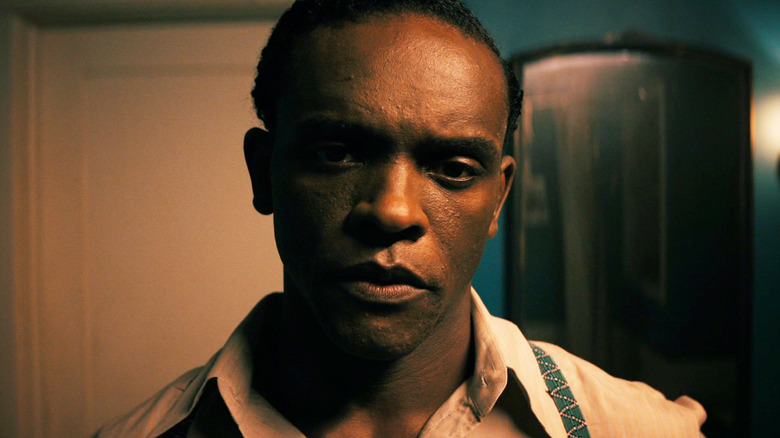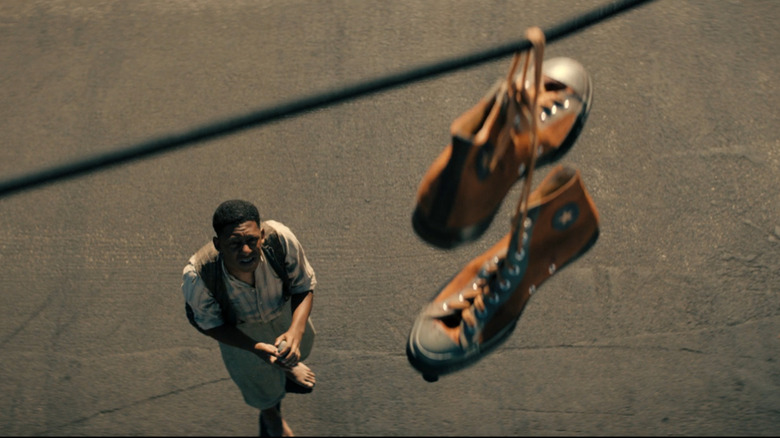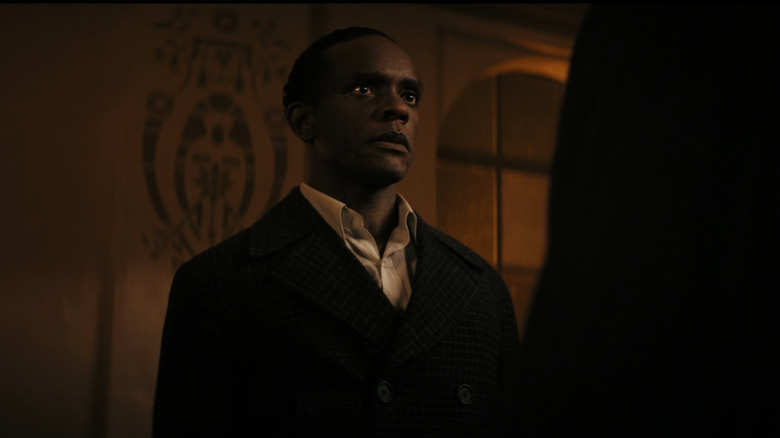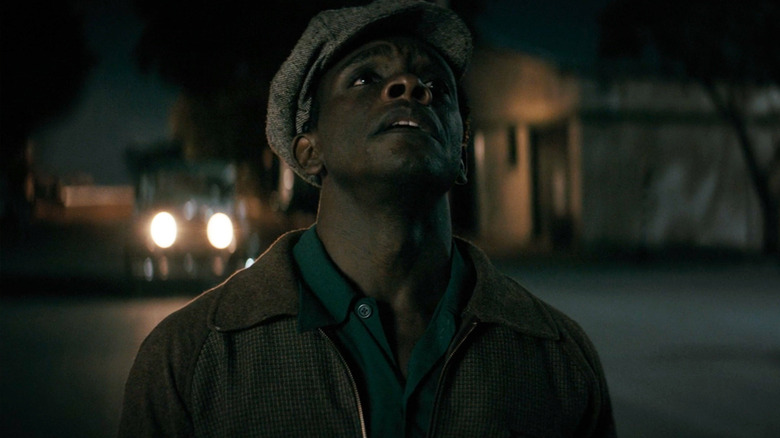Let's Talk About Those Bloody Sneakers In Perry Mason Season 2 – And What They Mean For The Show
This post contains spoilers for season 2 of "Perry Mason."
"Perry Mason" season 2 has switched things up pretty dramatically from the first season, bringing supporting characters to the forefront and creating a much more satisfying show in the process. Both Juliet Rylance's Della Street and Chris Chalk's Paul Drake have been given significant storylines, and at times Chalk has found the whole thing a bit depressing, noting how many of the issues faced by his character are still prevalent today. But it's not just the pervasive racism of 1930s Los Angeles that plagues Paul Drake. His transformation from a noble yet embattled beat cop to a promising yet tortured PI has come with its share of challenges.
At the end of season 1, Drake quit the Los Angeles Police Department, setting things up for season 2 wherein Perry Mason (Matthew Rhys), budding attorney Della Street, and lead investigator Paul Drake form the new Mason & Associates practice. While Street and Mason have faced their own struggles, Drake seems to be at the center of a protracted crisis, which Chalk told /Film will see the character "completely shattered" by the season's end.
One of the toughest parts of Drake's story to watch thus far this season has been when he was forced to beat low-level gangster Ozzie Jackson (Terrence Hardy Jr.). Under threat of having his own fists cut off "to the f***ing bone" by prolific criminal Melvin Perkins (Christopher Carrington), Drake has no choice but to beat Jackson relentlessly, even after extracting all the info he needs. Episode 6, opens with a shot showing Jackson's trademark orange Converse shoes hanging from a telephone wire as a local tries to hook them down. But what's the significance of the shoes? The episode returns to them multiple times, so what's the big deal? Allow us to explain.
The origin of the orange Converse
In episode 5 of "Perry Mason" season 2, the two brothers at the center of the court case, Mateo and Rafael Gallardo, tell Perry Mason they were paid to kill Brooks McCutcheon by Ozzie Jackson. As Mason's investigator, Paul Drake is tasked with tracking Jackson down with only one piece of info to go off: Jackson always wears Converse sneakers. Luckily, Drake gets some help from his brother-in-law, who knows Jackson as part of Melvin Perkins' crew but warns against getting too involved. Of course, that doesn't stop the ambitious Drake, who ends up tracking down Perkins and making a deal for access to Jackson. This ultimately leads to the scene in which Drake is coerced into "putting a beating on [Jackson] until [his] fist aches."
We're mercifully spared from witnessing the full beatdown, but by the time the scene cuts, Jackson is already pretty bloodied. Once Drake returns home to his wife Clara (Diarra Kilpatrick), it's obvious he's had to endure a fairly horrific experience, and the fate of Jackson remains unclear.
That leads to our all-important Converse on the telephone wire. This show loves a bit of shoe symbolism, with episode 5's credits rolling over the image of a girl's shoes burning. That particular image is a reference to the Gallardo brothers, who lost their little sister in a fire set by police forcibly removing local residents from their homes, likely having been paid off to make way for Brooks' stadium construction. The next episode then continues the footwear motif, opening on Jackson's orange Converse hanging over a street in broad daylight. After a kid manages to get them down and begins tying them up, he notices blood on the laces, suggesting Jackson may have met a fate worse than Drake's beatdown.
What does it all mean?
Aside from seemingly confirming that Ozzie Jackson didn't make it, the bloody sneakers hanging above a street are an ominous symbol of how things generally are slowly unraveling. Both Mason and Street are being tailed by an as-yet-unidentified man who will almost certainly cause problems for the pair as the main court case plays out, especially considering he knows about Street's love affair with screenwriter Anita St. Pierre. Meanwhile, Mason's case has seemingly been compromised following the discovery of the murder weapon in his office.
But it's really Drake who seems set to implode any minute. Throughout episode 6, he's haunted by those orange Converse, even as he tries to focus his efforts on identifying who paid Jackson off. Drake is already haunted by his beating of Jackson, which is taking a toll on his personal life, distracting him from his wife and causing arguments with his brother-in-law. It's all made worse when he encounters the man who retrieved those bloody sneakers and snaps.
In that sense, the sneakers serve as a representation of Drake's inescapable guilt. They symbolize a good man's descent into the murky underworld of LA and his psychological descent into inner turmoil. He can't escape the things he's done, just as he can't escape those bloody All-Stars. And, if you really want to get pretentious about it, the image of sleek, flashy sneakers stained with blood and dirt is an effective representation of Drake's morality stained with the marks of his immoral deeds. The fact these shoes are the first thing we see when the episode opens is important, in that it suggests things that were once good and whole are rapidly disintegrating. Which, for Mason and his colleagues, they very quickly are.
Drake is close to breaking point
By the end of episode 6, we see Paul Drake intently watching the street where he hopes to catch the man responsible for paying off Ozzie Jackson. Chris Chalk's stare in this moment suggests we're watching a man approaching boiling point. Once he spots and tries to pursue the mystery man, he's stopped abruptly by the kid wearing Jackson's All-Stars, who runs in front of his car, thwarting Drake's stakeout and once again reminding him of his misdeeds. It doesn't help that the kid in question seems to be about the same age as Jackson. And with both kids being Black, his image resembles the literal ghost of Jackson himself, haunting Drake and prolonging his internal torture.
This whole final sequence ends with Drake standing outside the very convenience store where those shoes once hung ominously over the street out front. By the time he utters an abject "No," we get the point that we're at a very fraught stage in the season, and things are about to get worse before they get better.
When will Drake snap? It seems likely to happen soon. Chris Chalk has talked about playing Paul Drake as being a double-edged sword, in the sense that, as he told Collider, "It was delicious and exhausting for Paul to always be at the edge and at his limit and confused. It was a wonderful exhaustion, but I definitely went home, all the time, like, 'Oh, my God, I've gotta go back tomorrow and be lost some more?'"
That confusion and feeling of being lost are leading to something, and just like those blood-stained sneakers portend, whatever it is, it isn't good.



